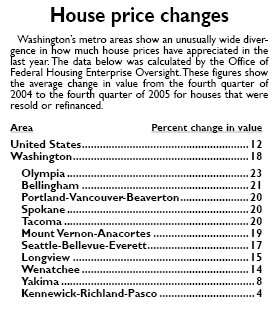
Surveys
Awards
DJC.COM
March 23, 2006
A bright outlook for local construction
AGC of America

Simonson
|
Jobs, jobs, jobs
The last 12 months have been very good for construction generally, but even more so in Washington. From January 2005 to January 2006, nonfarm payroll employment nationwide grew by 1.6 percent, seasonally adjusted, while construction employment grew at more than triple that rate, 4.9 percent. (Seasonal adjustment is a statistical technique that smooths out normal seasonal variation to reveal underlying economic trends or exceptional weather-related deviations.)
Washington and the Seattle metro area outpaced the nation on both counts. Statewide, nonfarm employment climbed by 3 percent, and construction employment was up a whopping 10 percent. In the Seattle-Tacoma-Bellevue area, nonfarm employment rose 4 percent, and construction employment swelled by 12 percent.
The federal Bureau of Labor Statistics, which posted these figures on March 9, also provided statewide detail on three construction subcategories. All three — building construction, heavy and civil engineering construction, and specialty trade contractors — showed double-digit employment growth.
Changing building patterns

|
Balanced growth among construction sectors was a hallmark of the industry during the year. The Census Bureau reported on March 1 that construction spending set a seventh straight record in January, at a seasonally adjusted annual rate of $1.16 trillion, up 0.2 percent from December and 7 percent from January 2005. (Annual rate means the monthly total has been multiplied by 12 to facilitate comparison with a full-year figure.)
That followed a 9 percent increase in 2005. In January, residential construction spending — on new single-family and multifamily construction plus improvements to existing homes — rose 0.1 percent from December, following an 11 percent jump in 2005. Private nonresidential construction gained 0.5 percent, on top of 5 percent growth in 2005. Public construction was up 0.2 percent for the month and 8 percent in 2005.
However, the rest of 2006 is expected to show a dramatically different pattern. There are several pockets of strength for private nonresidential construction, and more are likely to appear in 2006. Public construction will benefit from unexpectedly large increases in tax receipts in most states. Meanwhile, multifamily construction had already begun tailing off in January and is likely to contract more as investors' appetite for condos becomes sated.
Private nonresidential pickup
In 2005, the best growth for private nonresidential construction was in "multi-retail" — general-merchandise stores, such as big-box and warehouse-type retail, shopping centers and malls — which climbed 25 percent from 2004 to 2005. Manufacturing construction (22 percent increase in 2005) has continued the growth spurt it began in late 2004. Hospital construction was also up at double-digit rates, although other types of health-care construction were flat.
Each of these subsectors looks strong. Two retail examples: Issaquah-based Costco Wholesale announced on March 2 that it plans to open an additional 18 to 20 new warehouses by the beginning of September. Starbucks announced in February that it plans to open approximately 700 company-operated locations and 600 licensed locations in the United States this fiscal year.
Indicators for manufacturing construction in 2006 remain very positive, even though new orders and manufacturing construction slumped in January. The drop in new orders for manufactured goods was driven mainly by a plunge in aircraft orders from the extraordinary high totals Boeing had booked late last year.
Non-transportation orders actually accelerated for the fourth straight month. That reinforced reports from the Federal Reserve in mid-February that industrial production in manufacturing was up 4.5 percent from January 2005 to January 2006, and factory capacity utilization was above its long-run average level. Together, orders, current output and capacity utilization point to more factory construction.
Health-care construction will receive boosts from the introduction of the Medicare prescription drug benefit this year, along with continuing increases in spending by employers, consumers and governments at all levels on medical devices, treatments and research.
In addition, there are strong indications that construction will increase for hotels and resorts, freight transportation and distribution facilities, and a variety of alternative and conventional energy projects.
Public bonanza
On the public side, the federal government is increasing its grants to states for highway construction, defense and homeland security-related projects. Most states have received unexpectedly large amounts of sales, income or severance taxes, and are putting some of that money into construction of university and adult-education facilities, parks and conservation, courts and correctional institutions, and water and sewer projects. Local governments and school districts nationwide that depend on property-tax receipts have benefited from the steep rise in property values.
One measure of that increase is the house price index posted on March 1 by the Office of Federal Housing Enterprise Oversight. OFHEO calculated the average increase between the fourth quarter of 2004 and the fourth quarter of 2005 in the value of houses that were resold or refinanced using loans from Freddie Mac or Fannie Mae. Appreciation averaged 13 percent nationwide and 18 percent in Washington. OFHEO also calculated appreciation for 11 metro areas, ranging from 4 percent in Kennewick-Richland-Pasco to 23 percent in Olympia.
Housing hiatus
The only part of the construction market that looks cloudy is residential. Even here, some rays of light appear.
First, single-family homebuilding is holding up better than multifamily, for now at least. The value of single-family construction spending in January was up 0.1 percent from December, while multifamily fell 1.5 percent. Further, builders have large inventories of paid-for but unbuilt houses. That will prolong construction activity even as sales slow.
Second, the decline in condo projects may be offset by a pickup in rental housing if more people are forced to wait longer before they buy a home.
Here again, Washington is better situated than most of the country. The nation's population grew by 0.9 percent from July 2004 to July 2005. Washington's population rose by 1.3 percent, the 14th fastest among 50 states and the District of Columbia. That was enough to nose out Indiana as the 14th most populous state. More important, it means Washington will continue to have elevated demand for housing, whether rental or owner-occupied.
Ahead of the country
Nonresidential construction appears to be in good shape to build upon the momentum of the last year. Manufacturing, hospital, and multi-retail construction remain the best bets. Transportation and distribution facilities should expand, given rising manufacturers' shipments, retail demand and strong profits among freight carriers.
Lodging and medical office construction, which have flattened lately, should resume growing. Education and general public categories will benefit from rising tax revenues. Even office construction will pick up in selected markets. Condo construction is likely to slow, but multifamily rental construction should do better in 2006.
Nationally, cement availability is the biggest worry among materials. Scarcity will be accompanied by higher prices, even in regions such as this one, where cement remains available. Steel, oil and plastics products could go either way in price, while gypsum prices should ease by yearend. Labor costs should remain moderate, with adequate supply in most markets for most occupations.
Washington remains ahead of most of the country in attracting residents. That will help bolster residential, school and retail construction, even though condo development is at risk in the near term. The state also faces challenges in getting enough cement and construction workers.
Ken Simonson is chief economist for Associated General Contractors of America, a national construction trade association. He writes The Data DIGest, a weekly one-page summary of economic news relevant to construction.
Other Stories:
- Joint ventures are like marriages — know your partner
- Scoccolo case could hurt contractors, taxpayers
- See through walls to find water leaks
- How much do you know about forklift safety?
- Are you communicating clearly? Your bottom line is at stake
- Sound Transit digs a cutting-edge tunnel
- Need a tower crane? Take a number
- It only takes a minute — to get hurt
- Get a handle on escalating costs
- Engineered lumber makers step it up
Copyright ©2009 Seattle Daily Journal and DJC.COM.
Comments? Questions? Contact us.